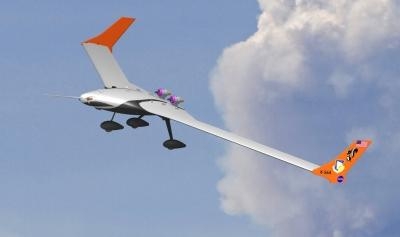Mon, Mar 05, 2012
UAV Will Be Used In Aircraft Configuration Research
The Air Force Research Laboratory was recently awarded an
X-Plane designation for a vehicle that will be used to explore
active control of lightweight, aerodynamically-efficient aircraft
configurations. The X-56A is an innovative, modular, unmanned fight
research vehicle that will allow investigation of active flutter
suppression and gust load alleviation technology.

Flutter is an instability that can occur when unsteady
aerodynamic loads acting on a wing couple with its natural
vibration modes, often resulting in catastrophic failures. The
research to be conducted with the X-56A is critical for the
successful development of future slender, lightweight, high aspect
ratio wing designs that could be used by energy efficient transport
and unmanned aircraft.
The X-56A, also known as the Multi-Utility Technology Testbed
(MUTT) flight demonstrator, is a product of the AFRL-led
Multi-Utility Aeroelastic Demonstration (MAD) program. This program
is a joint effort between AFRL's Air Vehicles Directorate, NASA
Dryden and Lockheed Martin.
The X-56A is powered by twin JetCat P240 turbojets, has a
28-foot wing span, weighs 480 pounds, and is designed and
constructed for easy wing replacement to enable testing of various
flexible wing configurations. An additional hard point is being
designed into the center of aft upper deck of the fuselage for
mounting an additional third engine or a structural member to
support testing of joined wing configurations. These
characteristics will allow the testing of a wide range of advanced
aerodynamic concepts. The X-56A will exhibit multiple rigid body
and aeroelastic instabilities within its flight envelope, which
will be actively managed by its flight control system.
The first X-56A flight is scheduled for summer 2012. Following
Air Force flight testing, the X-56A will be used by NASA's Dryden
Flight Research Center for their continuing research into
lightweight structures and advanced technologies for future
low-emissions transport aircraft.
More News
He Attempted To Restart The Engine Three Times. On The Third Restart Attempt, He Noticed That Flames Were Coming Out From The Right Wing Near The Fuel Cap Analysis: The pilot repor>[...]
Make Sure You NEVER Miss A New Story From Aero-News Network Do you ever feel like you never see posts from a certain person or page on Facebook or Instagram? Here’s how you c>[...]
From 2009 (YouTube Edition): Leading Air Show Performers Give Their Best Advice for Newcomers On December 6th through December 9th, the Paris Las Vegas Hotel hosted over 1,500 air >[...]
Aero Linx: NASA ASRS ASRS captures confidential reports, analyzes the resulting aviation safety data, and disseminates vital information to the aviation community. The ASRS is an i>[...]
“For our inaugural Pylon Racing Seminar in Roswell, we were thrilled to certify 60 pilots across our six closed-course pylon race classes. Not only did this year’s PRS >[...]
 NTSB Final Report: Rutan Long-EZ
NTSB Final Report: Rutan Long-EZ ANN FAQ: Turn On Post Notifications
ANN FAQ: Turn On Post Notifications Classic Aero-TV: ICAS Perspectives - Advice for New Air Show Performers
Classic Aero-TV: ICAS Perspectives - Advice for New Air Show Performers ANN's Daily Aero-Linx (06.28.25)
ANN's Daily Aero-Linx (06.28.25) Aero-News: Quote of the Day (06.28.25)
Aero-News: Quote of the Day (06.28.25)



